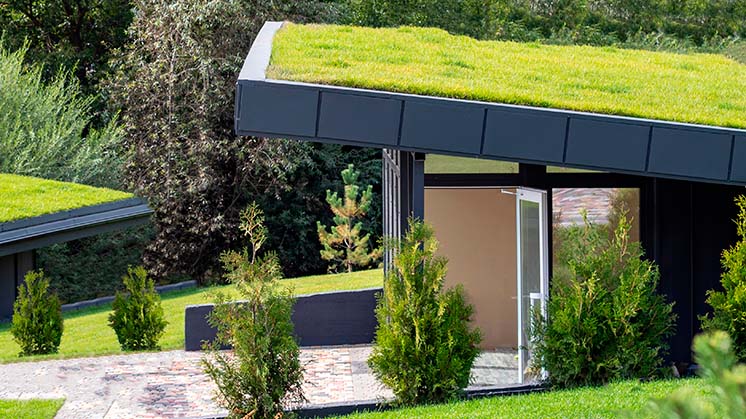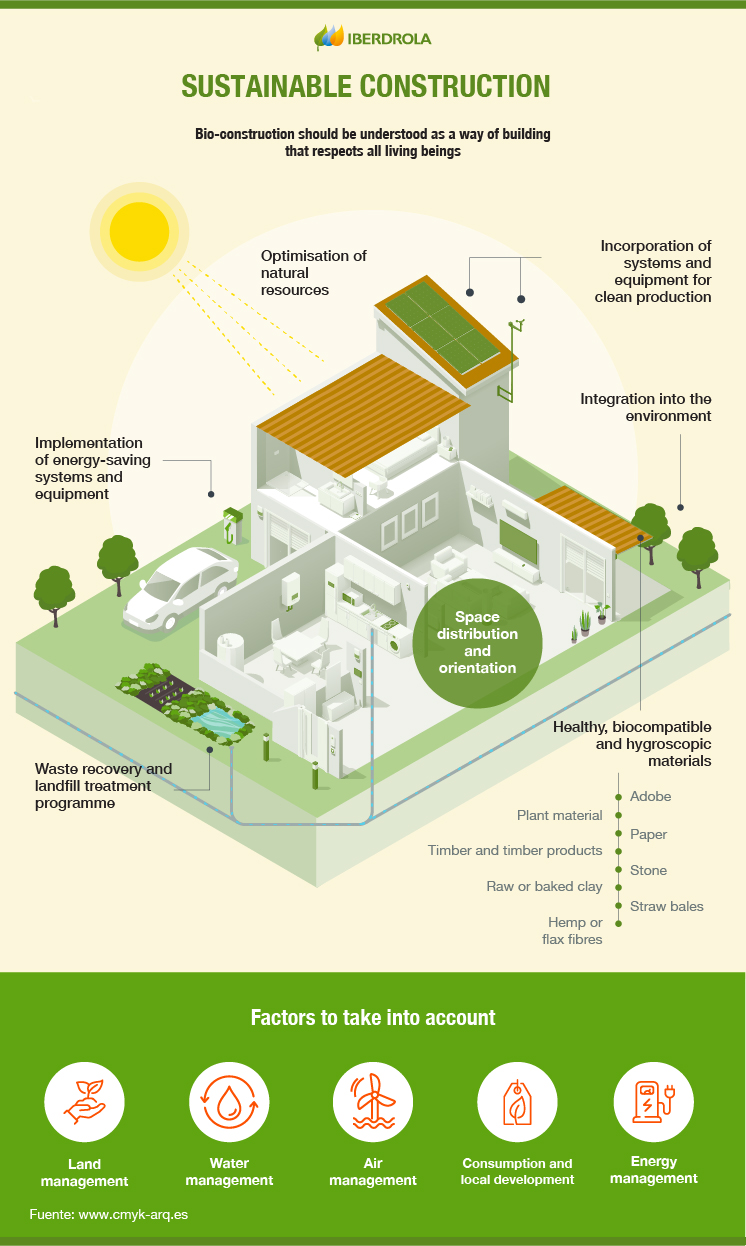Bioconstruction
What is bio-construction
Despite its influence on the development of cities, bio-construction of buildings has not been a priority until recently. The focus has been on properties such as energy savings, temperature insulation and, to a lesser extent, durability of buildings. Today, having understood the message that everything adds up to curb climate change, we are beginning to value building materials, seeking to make them as environmentally friendly as possible, and the environment in which we build.

Bio-construction and sustainable arquitechture
Bio-construction is understood as a form of construction that respects living beings and the environment. It is also a type of sustainable architectural style whose aim is to achieve the integration of the building with its surroundings, minimising its impact on them.
In order to carry out this type of construction, it is necessary to have a complete knowledge of the natural and cultural environment in which the building is to be constructed. Only in this way will it be possible to achieve an adaptation to the landscape, society and local customs.
Bio-construction is not new as a concept. Traditional construction, before the proliferation of concrete, iron and steel, was made by hand from earth, stone or wood. They were sufficient shelter for their tenants and, in fact, many of these constructions can still be seen today in villages and towns, some of them in good condition.
The terms sustainable construction and bio-construction, as well as bioclimatic architecture, can be easily confused. In fact, they can be used interchangeably to refer to environmentally friendly engineering works. The differences, however, are subtle but concrete:
- Sustainable construction was defined in 1994 by the Conseil International du Batiment (CIB). It states that it is "creating and operating a building with a healthy environment, based on ecological design and efficient use of natural resources".
- Bio-construction applies many, if not most, of the concepts of sustainable construction, but allows for the evaluation of the efforts and impacts of a building on the environment and the immediate surroundings.
Therefore, when we talk about sustainable construction, we emphasise the final destination of the construction by considering the elements from the conception of the project. If we talk about bio-construction, we refer to a construction that:
- Provides a practical and ethical response to environmental issues, as well as to the human impact on the consumption of natural resources.
- Seeks the least environmental impact while maximising the financial viability of the construction project.
- Focuses on minimising the potential impacts of the building on the health and quality of life of its occupants during use and operation.

 SEE INFOGRAPHIC: What is bioconstruction? [PDF]
SEE INFOGRAPHIC: What is bioconstruction? [PDF]
Bases and foundations of bio-construction
As we have said, bio-construction shares many of its fundamentals with green or sustainable construction, but it goes further. In considering not only the most environmentally friendly building materials and techniques, but also the impact on the natural environment and the occupants' own health and well-being, the following points need to be taken into consideration:
Land management, i.e. actions involving control over land use.
Water management, with a focus on the preservation of water resources.
Air management, with particular emphasis on the selection of materials that avoid or minimise the emission of volatile organic compounds, as well as the installation of adequate ventilation systems.
Energy management, i.e. constructing buildings with maximum energy efficiency.
Local consumption and development, seeking to optimise available resources without exhausting or affecting the environment, recycling and reusing.
Bioconstruction is based on a series of fundamental bases and principles that guide its activity and achieve the desired result. These fundamental principles are:
The search for the right location
One of the main keys to bio-construction is to find a location far from any ecosystem that could be affected by the building, but which, in addition, does not affect the occupants of the future home. We are talking about sources of electrical and electromagnetic, chemical or acoustic pollution, such as polluting factories, large communication routes, high-voltage power lines, substations or transformer stations.
In addition, construction on known geological faults, watercourses or other tellurism features should be avoided.
Study of integration with the environment
When a bio-construction project is undertaken, it is necessary to think about inclusion rather than occupation. For this reason, aspects such as the morphology of the terrain, the buildings close to the site, the traditional architectural styles of the area (which is linked to the protection of the cultural environment), and also the vegetation of the area are taken into account.
Customised design
The dwelling should be fully adapted to the lifestyle and needs of its occupants, so that they can develop their way of life as naturally as possible.
Space distribution and orientation
In a bio-construction project, attention is paid to the distribution of the different services, bearing in mind bioclimatic, energy-saving and functional considerations. Therefore, the search for the best orientation is fundamental, as well as all the thermal insulation and light use actions.
Another significant example is the location of resting places, for which special attention should be paid to ensure that no water pipes run vertically to disturb people's rest.
Attention to layout and orientation is undoubtedly one of the most important key points of bio-construction.
Use of appropriate materials
Materials are another key factor in bio-construction. As a matter of principle, they should come from the local area (local production) and be raw materials that are free of elements such as asbestos, polyurethane, chlorine or PVC.
There are a large number of healthy and hygroscopic building materials that allow the house to "breathe", i.e. to allow moisture exchanges between the building and the atmosphere. By choosing and using such materials that are also biocompatible, we will be contributing to a construction that is better integrated with the environment.
Optimisation of natural resources
The use of natural resources in housing allows energy efficiency and, in addition, considerable savings. We are talking about the use of sunlight as a source of light and heat, including the generation of electrical energy through photovoltaic panels; the treatment of water from its collection, accumulation, use, purification, reuse and its return to the natural environment; or the use of wind, with which air conditioning systems can be adopted that take advantage of the differential pressure for ventilation or cooling in hot periods.
Saving systems and equipment
From a location that allows the use of natural resources and the local climate, different systems can be designed and installed to save energy, such as passive solar collection systems, controlled ventilation galleries or plant systems that regulate temperature and humidity.
There are many solutions in this area and they make it possible to achieve homes that are highly integrated with their surroundings in any location and in any climate.
Incorporation of cleaner production equipment and systems
From the above, it is clear that bioconstruction allows the use, exploitation and generation of clean energies, such as geothermal, biomass, solar photovoltaic, hydraulic or wind energy, depending on the local availability of these energies in any of their forms, and as long as their impact on the environment is minimal.
Waste recovery and effluent treatment programme
Waste management must be present from the beginning of any bioconstruction project. For this reason, waste separation at source should be taken into account and, if possible, a recycling and reuse programme for solids (e.g. by composting organic waste) should be in place. Wastewater treatment is also essential so that wastewater can be reused for, for example, irrigation.
Green buildings
Green buildings are sustainable buildings that benefit society by minimising energy and water consumption, and are one of the main tools of sustainable urban development in the fight against climate change. Moreover, because of their construction and equipment, green buildings can improve the quality of life in their immediate surroundings.
An example of this type of sustainable construction is our Iberdrola Tower, the group's headquarters. It is a 165-metre-high glass structure that has become a financial and business icon in Bilbao, as well as being the tallest skyscraper in the Basque Country.
Designed by the architect César Pelli, it is a benchmark in sustainable design and energy efficiency. In addition, its internal layout encourages teamwork, knowledge transfer and organisational learning in an environmentally friendly space.
Circular economy model at the Iberdrola Group
At Iberdrola, we work to be more respectful of nature in our three strategic sustainability areas: climate action, biodiversity protection, and circular economy.
For this reason, our sustainable business model is based on the circular economy model, a system for making the most of resources in which priority is given to reducing the use of new raw materials through efficiency in processes, product life extensions, and a firm commitment to the reuse and recycling of materials.




